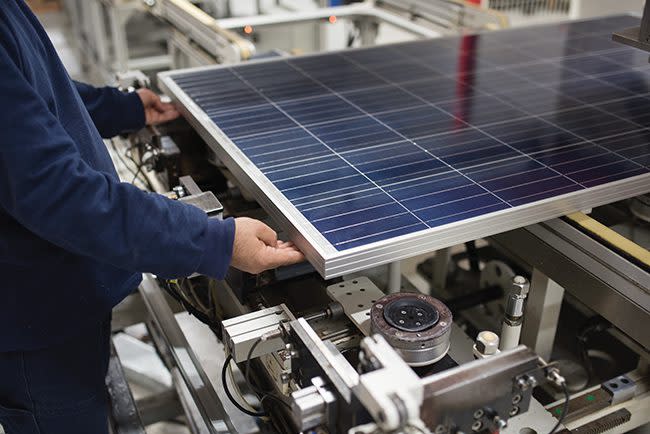Optimizing Solar Panel Manufacturing Efficiency and Reliability

Whether you’re a longtime solar panel maker or just embarking on a business plan, it’s easy to overlook some key business considerations. Perhaps you need to design a new warehouse and develop support systems infrastructure but don’t know where to start. Or you are unaware of technologies that will enhance your operations. Or, even more frustrating, you discover afterward you missed out on some key tax provisions. Given the rapid rise in the solar market, solar panel manufacturers would do well to stay apprised of the latest trends. According to the Solar Energy Industries Association, the U.S. solar market has experienced an average annual growth rate of 24% during the past 10 years. To realize continued growth, solar panel makers need to consider a host of issues to remain vital in a competitive marketplace. They should pay attention to best practices for running a plant smoothly, consider a range of new technologies available, and take advantage of tax provisions that will lead to enhanced business operations.
Creating Efficiencies
To thrive as solar panel makers, operators should follow planning steps focusing on proper preparation, specifications, qualifications and certifications, production, and sustaining processes. In many cases, solar panel makers have yet to consider these areas, which can lead to operating losses and a lack of customers. At the outset of manufacturing, solar operators need to consider process design and equipment design, as well as specifications and characterization. This includes selection and sourcing of the proper materials. Operators must be trained and certified. Additionally, operators must be mindful of the software they plan to use, whether using enterprise resource planning (ERP), manufacturing execution system (MES), or some other support system. In rounding out the to-do list, Noel R. Cena, vice president of Operations at PANASOL USA, recommends following the Advance Product Quality Planning, or APQP methodology, which covers 23 activities to be monitored. These are divided into five milestones: planning, product approval, prototyping, pilot run, and production launch.
 |
1. A worker inspects the framing of a solar panel, part of the process as the panel enters its final stage of production. Courtesy: PANASOL USA |
Solar panel makers should also consider implementing a sustainable quality control program (Figure 1) such as a Six Sigma set of methodologies, a root cause analysis, or an eight-discipline (8D) model for problem-solving. By following an overall assessment, operators can create a solid foundation for the company.
Explore Top Technologies
Most manufacturers supply what the market demands regarding technologies around solar panel manufacturing. The most common technologies include Monocrystalline Passivated Emitter and Rear Contact, or Mono-PERC; bifacial (glass-glass or glass-back sheet); and half-cut solar panels. These technologies are not exclusive to each other, though; the differentiation of each type of module manufactured is based on your clients’ needs. For instance, if you’re servicing the roof-top sector, whether residential or commercial and industrial, the size of the panels does matter. In the case of residential customers, the aesthetics are also important, and hence, the selection of materials, whether the modules are silver-framed or black-framed. Solar panel makers should also consider introducing new technologies to boost their operations in terms of differentiation and seeking to enhance efficiencies. Some of the forthcoming technologies include: ■ Heterojunction (HJT) Cells. HJT cells offer improved efficiency by combining different semiconductor materials. According to MIT Technology Review, they can reduce energy losses at the cell surface, which results in better performance. ■ TOPCon (Tunnel Oxide Passivated Contact). TOPCon cells use a thin tunnel oxide layer to enhance electron transport. Industry leader SunRun says they achieve high efficiency by minimizing recombination losses. ■ Perovskite Tandem Solar Cells. These cells combine traditional silicon with perovskite materials with a unique crystal structure. Perovskite tandem cells can utilize a broader spectrum of sunlight, resulting in higher efficiency. While silicon-based cells top out at about 23% efficiency, perovskite tandem cells have already exceeded 33% efficiency in the lab. Exploring top technologies is a big-ticket item in this industry. It can come with a hefty (but potentially worthwhile) price for those who mean business. An aggressive and proactive research and development effort must form part of the strategy, not just for the long term, but also for competitive survival. New product introductions focused on new methods, materials, and cost reductions are vital for making inroads to leadership in this industry.
Don’t Forget Tax Provisions
When President Biden signed the Inflation Reduction Act (IRA) into law nearly two years ago, it spurred a host of significant tax provisions for solar panel manufacturers in the U.S. The IRA has a provision called Section 45X, a tax credit for businesses that manufacture and sell energy components. To qualify for the 45X production tax credit, U.S. makers need to sell their production to non-related clients based in the U.S. Solar makers can cash or trade their tax credits set at 7¢ per watt. That means a 1-GW factory can generate a non-taxable $70 million per year on the tax credits alone. This is a hefty return on investment, allowing manufacturers to lower their tariffs to attract more consumers. The tax credits will impact the production of solar panels in the U.S. Solar operators are seeing a sizeable flow of investment in the industry, which will increase competition and help to reduce prices, leveling the field. The past year has seen an increase in announcements of new factories nationwide, increasing the supply to an estimated 62 GW by 2025, according to industry data. There is no doubt that creating and maintaining an effective solar panel operation can be challenging. But in the end, solar panel makers who create and follow an efficient business model, invest in top technology, and take advantage of tax provisions will thrive for years to come.
—Ricardo Jimenez is the founder and chairman of PANASOL USA LLC.

 Yahoo Finance
Yahoo Finance 